Dr Nial Moores, Birds Korea, August 26th 2024 (with additional information and images, September 1st)
The simplified 2024 Birds Korea Checklist includes Hartert’s Leaf Warbler Phylloscopus goodsoni for the first time. The species is included in a Review Category (i.e., not in the list of adequately-documented species) on the basis of a leaf warbler, either the less yellow-saturated fokiensis subspecies of Hartert’s or a bright-looking Claudia’s P. claudiae, documented by Dr Kim Sung-Hyun, Kim Jeong Won, Kang Chang-Won and Kang Heeman on Marado, Jeju, on April 4th 2024.
The following post aims to provide background information and then to elicit expert opinion on this bird, to help determine whether or not the bird on Jeju can be identified to species (both as part of work for Birds Korea and also as reviewers for eBird). Please let us know your thoughts…

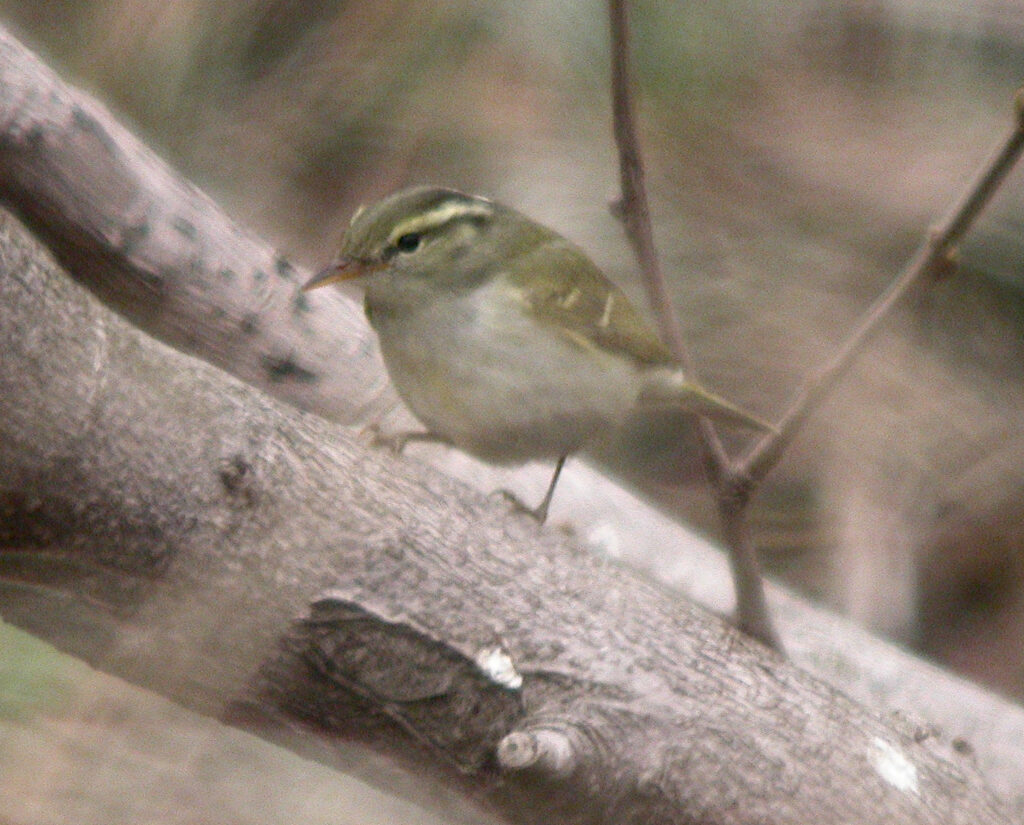
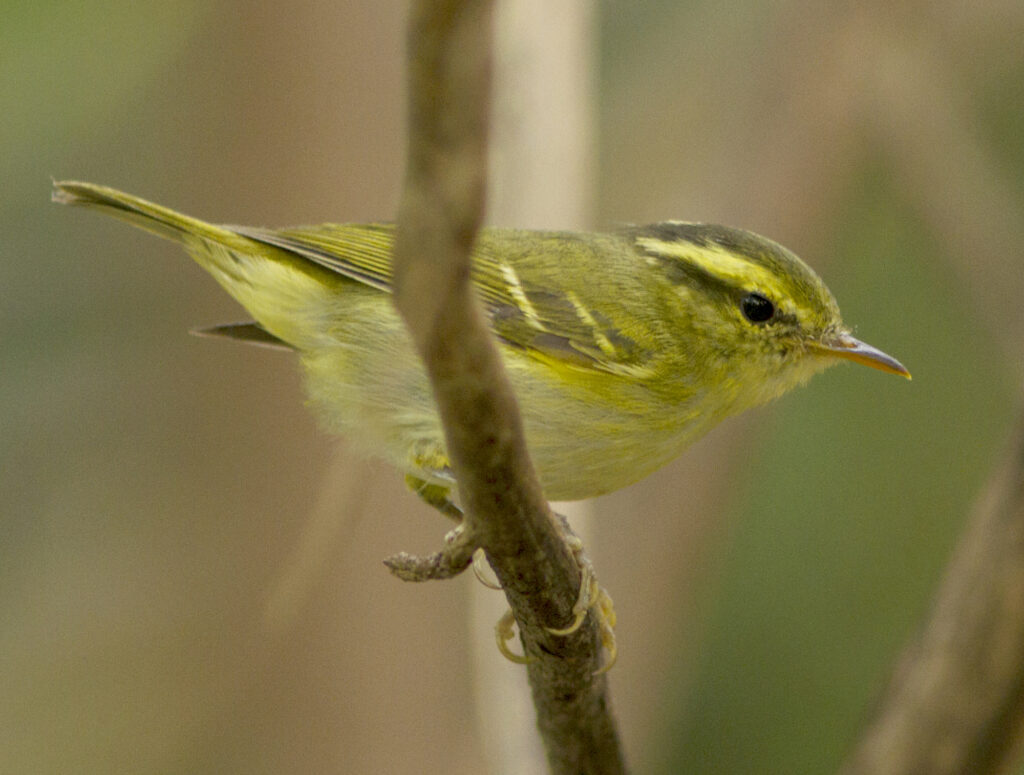

- Background
(1) Blyth’s Leaf Warbler Phylloscopus reguloides was split only 20 or so years ago into three very similar-looking species: (i) Blyth’s Leaf Warbler Phylloscopus reguloides sensu stricto, with three subspecies, which all seem very unlikely to occur in Korea because they are all largely resident or altitudinal migrants, with breeding ranges that run west-east along and to the south of the southern edge of much of the Himalayan Massif – resulting in the Korean name of 히말라야산솔새 (“Himalayan Eastern Crowned Warbler”); (ii) Hartert’s Leaf Warbler Phylloscopus goodsoni which has two migratory subspecies both of which breed in southern China (Fig. 5) – the yellower nominate to the southwest (Fig. 3 above), and the whiter-below fokiensis to the east and northeast (a species which eBird suggests on occasion reaches as close to Korea as Shanghai); and (iii) Claudia’s Leaf Warbler Phylloscopus claudiae (Fig. 4 above) a longer-range migrant which breeds to the west and north-west of Korea (Fig. 6), with substantial numbers reaching as far north as mountain forest in Beijing in summer. Based on Claudia Leaf’s frequent Nuthatch-like foraging behaviour and its northerly breeding range, this resulted in the coining by Birds Korea of the Korean name of 북방동고비솔새 (“Northern-distributed Nuthatch-like leaf warbler”).
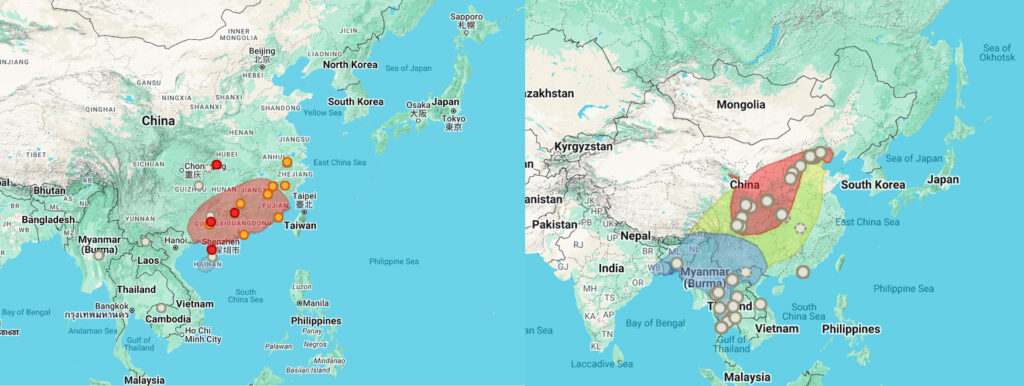
(2) Although relatively easy to identify to species-pair if seen or heard in much of China or anywhere in Korea, separation of Hartert’s from Claudia’s appears from available literature to be a major ID challenge. This challenge is likely to be greatly compounded e.g., by older treatment of P. claudiae and P. goodsoni fokiensis as subspecies of Blyth’s and of nominate goodsoni as a subspecies of Sulphur-breasted Leaf Warbler P. ricketti (Round et al. 2023); individual variation and wear; the lack of appropriately detailed literature, at least in English; and the possibility of misidentified individuals being posted online.
Most English-language accounts and images appear to suggest simply that Hartert’s look brighter with more yellow and green tones than Claudia’s. For example, Round et al. (2023) state that they both share with Blyth’s, ” a pale median crown-stripe, two wingbars and narrow white edges to the inner margins of the two or three outermost rectrices” and that “P. claudiae and P. goodsoni differ from each other chiefly in the degree of yellow suffusion on their face and underparts, although this is difficult to judge under field conditions”. del Hoyo et al (2020) currently state, “Until recently [Claudia’s] considered conspecific with P. reguloides [Blyth’s] and P. goodsoni [Hartert’s] but separated on basis of deep molecular divergence and vocal differences. This arrangement provisionally accepted here pending further evidence on voice, distribution and habitat, although the taxon currently fails to meet required criteria under the scoring system used herein, differing in its whitish vs dull yellowish-white supercilium and underparts; marginally less white in tail; and relatively distinctive song (a simple repeated note), although a second song type is virtually inseparable from songs of others (implications unknown).”
In support of the statement on vocalisations in Birds of the World, the variation in song types provided on Xeno-Canto suggest that – if the identifications have been made correctly – both Claudia’s and Hartert’s show obvious variations in their songs. There also seems to substantial variation in calls. Based on recordings on Xeno-Canto, Claudia’s calls seems to vary out from a slightly thinner, sometimes hesitant, “pii-Pit-Tuu” (like the Socheong bird in 2009: listen below) while some calls labelled as Hartert’s sound a little more explosive initially, before trailing off a little, “PEE-PIT-chuu”). Either way, as a result of the fairly wide-seeming variation, some songs and calls sound obviously different from each other while others sound confusingly similar.
Some leaf warbler species do have two distinctively different song types (e.g., Eastern Crowned Warbler P. coronatus), but it seems genuinely extraordinary that Claudia’s and Hartert’s could share a similar song type or types and also seem to have overlap of some kind in calls. At the very least, it is important to recognise that what are currently thought to be variations in their vocalisations likely increases the possibility of misidentification of individuals both outside and even within the breeding range; and that this situation has likely helped to confuse the development of ID criteria based on plumage and structure.
(3) Although brighter Claudia’s and duller Hartert’s presumably need to be left unidentified if silent or giving overlapping vocalisations, online images (correctly or incorrectly) suggest that birds showing extensive grey on the head are identified / identifiable as Claudia’s (presumably being out of the expected plumage range of Hartert’s); and those showing extensive yellow on the underparts are identified / identifiable as Hartert’s (some fokiensis, and perhaps most or all nominate goodsoni). One obvious question: where is the cut-off point, where identification is considered safe based only on brightness or dullness?
(4) I have seen two “grey-shawled”, dull and cold-looking, Nuthatch-like foraging leaf warblers in the ROK that I identified as Claudia’s: one digiscoped on Socheong Island on April 14th 2009 (Figures 2 and 7-10 below), as part of a major arrival including some “western” migrants (such as Red-throated and Black-throated Thrushes); and one, seen only, on Baengynyeong Island on April 26th 2021. Identification of the first bird was based on input from several fieldworkers with experience of these species; and no requests to reconsider the record were sent to us following posting of images at that time and in the old Birds Korea gallery. (Now that knowledge of these warblers has improved, should this identification stand, or should this too be considered as a Claudia’s / Hartert’s ?)
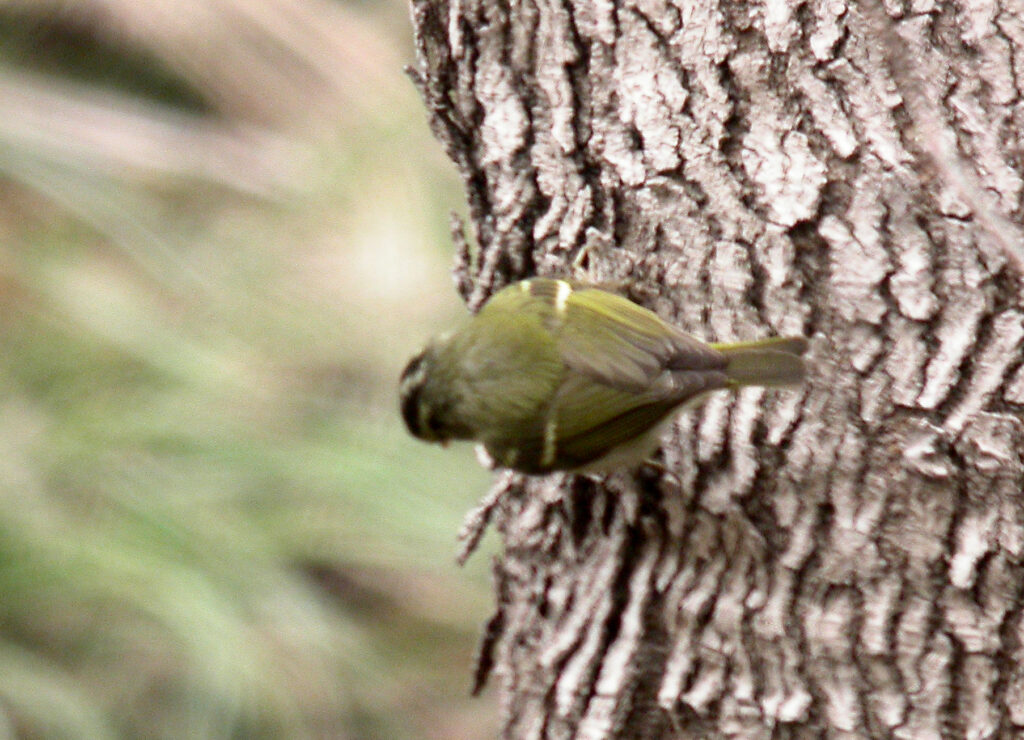

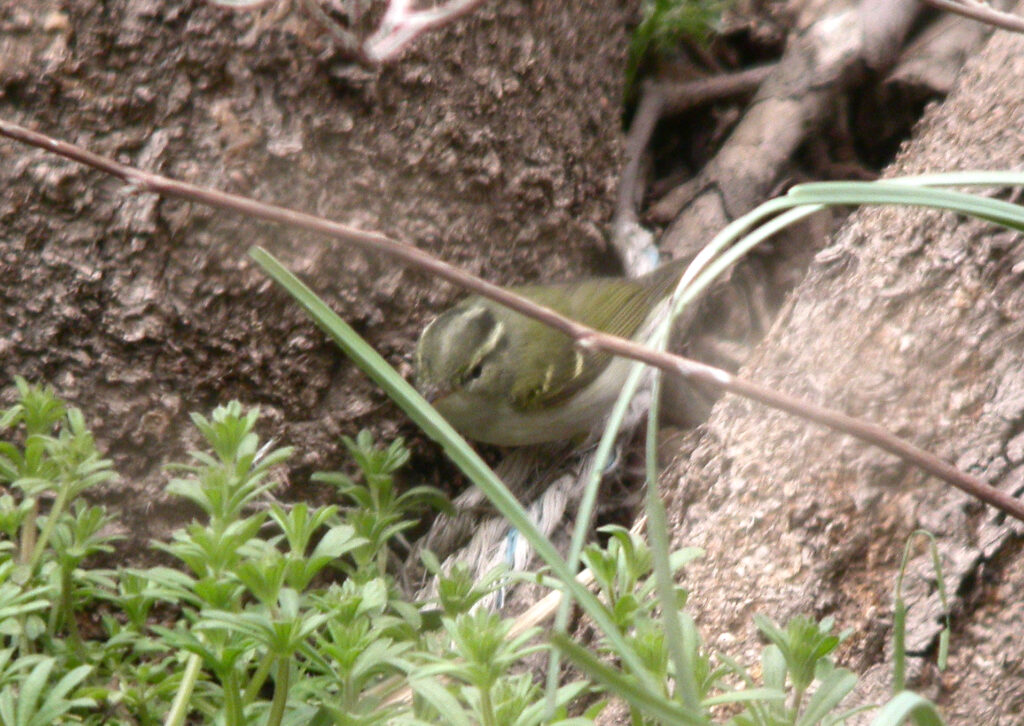
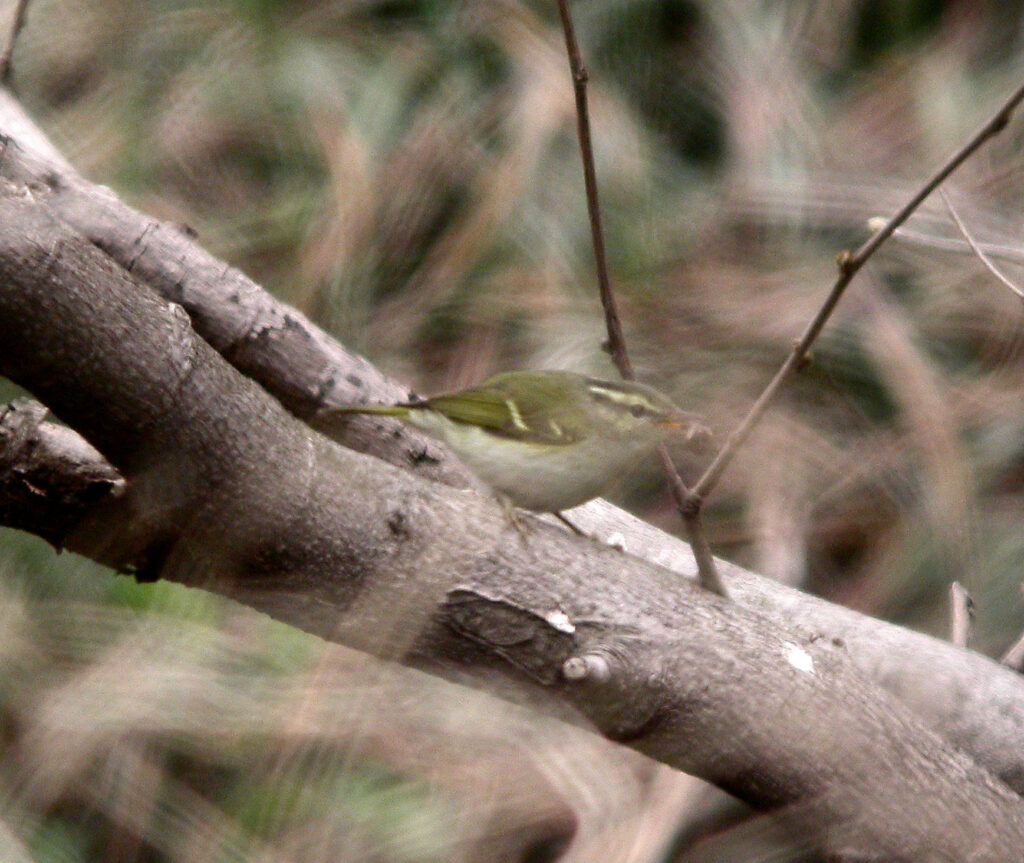
(5) On April 14th 2009, I also sound-recorded what I presume(d) to be the call and song of a Claudia’s multiple times over a one-hour period (most likely given by the digiscoped Claudia’s, though that bird was never actually seen in song, and the song was coming from an area of tangled trees about 100m from where I digiscoped the bird). I also briefly heard the call and 2-3 song phrases (either Claudia’s or Hartert’s) on Socheong Island on April 25th 2010.
Presumed Claudia’s Leaf Warbler Phylloscopus claudiae: several “hesitant” calls and a short burst of song, Socheong, Incheon, April 14th © Nial Moores
Back in 2009, there were very few resources available to check songs and calls; and I did not receive a definitive yes or no from several experts (including Prof. Jochen Martens) when I sent sound files only. Growth of the archive on Xeno-Canto now allows a more robust comparison. The Socheong bird did not give a song similar to (most of? all of?) the recordings of Claudia’s in Hebei to the north of the range. However, the song does sound similar to some individuals recorded in Hubei Province, toward the south of the breeding range, e.g., XC807627, XC8075672 and XC8075670. Is this the second song type described in Birds of the World? Is this song-type or subsong (?) given by all populations or is it usually given only by southern populations or on migration?
(6) Various online accounts and especially online images in the Macaulay library (filtered for months March-May only, focusing on images taken in the respective breeding ranges) suggest that in spring, when plumage is at its most worn and dull, most birds identified as Hartert’s look rather brighter than Claudia’s. Although some regional field-guides (e.g., one covering Taiwan) suggest that Hartert’s might have a marginally greater total length than Claudia’s (11-12cm compared to 10-12 cm), to my eyes Hartert’s in many of the images look a little less heavily built, with perhaps a slighter and shorter bill.
(7) In the same online images in the Macaulay library, fokiensis Hartert’s appear to have more green in the crown sides, more yellow in the supercilium, and a stronger, brighter blaze on the closed wing than most Claudia’s, while most Claudia’s in March-May look colder-toned, often with more greyish tones on the head, neck sides and mantle, with many of the greyest birds looking obviously “shawled” (cf 2009 bird on Socheong; and the 2021 bird on Baengnyeong) or even hooded (cf Figure 4 above). In some of the same images, the facial pattern also appears modestly or strongly weaker in many Hartert’s than in Claudia’s, with some Hartert’s having a weaker loral line, a weaker eye-stripe behind the eye with less filled-in ear coverts, and often greenish rather than dark grey washed crown sides.
(8) In spring, the same online images suggest that the leg colour of Hartert’s can be paler than often seen in Claudia’s, which more often appears to have darker greyish legs with paler or concolorous feet. A few Claudia’s also appear to show some weak dark smudge on the lower mandible, while the bill of Hartert’s more often looks rather brighter orange on the lower mandible, without any dark markings.
(9) Both Claudia’s and Hartert’s show some white or grey-white in the tail (both apparently less extensively than Blyth’s), which is most apparent on the underside of the tail, and especially when the tail is spread. A figure in a pdf by Alstrom (2012) perhaps suggests that Claudia’s might show more extensive white on the second outermost pair of tail feathers than Hartert’s. Do details of white on the tail have any value as an ID feature when trying to separate Claudia’s and Hartert’s?
(10) Even though Claudia’s is thought to migrate substantially greater distances than Hartert’s, online images suggest that Hartert’s and Claudia’s might show (broadly) similar primary spacing. Are there any useful differences in wing formulae between them that can be used in ID? If so, what are they?
2. Mara Do, Jeju, April 4th 2024 (documented by Kim Sung-Hyun, Kim Jeong Won, Kang Chang-won and Kang Hee-Man).
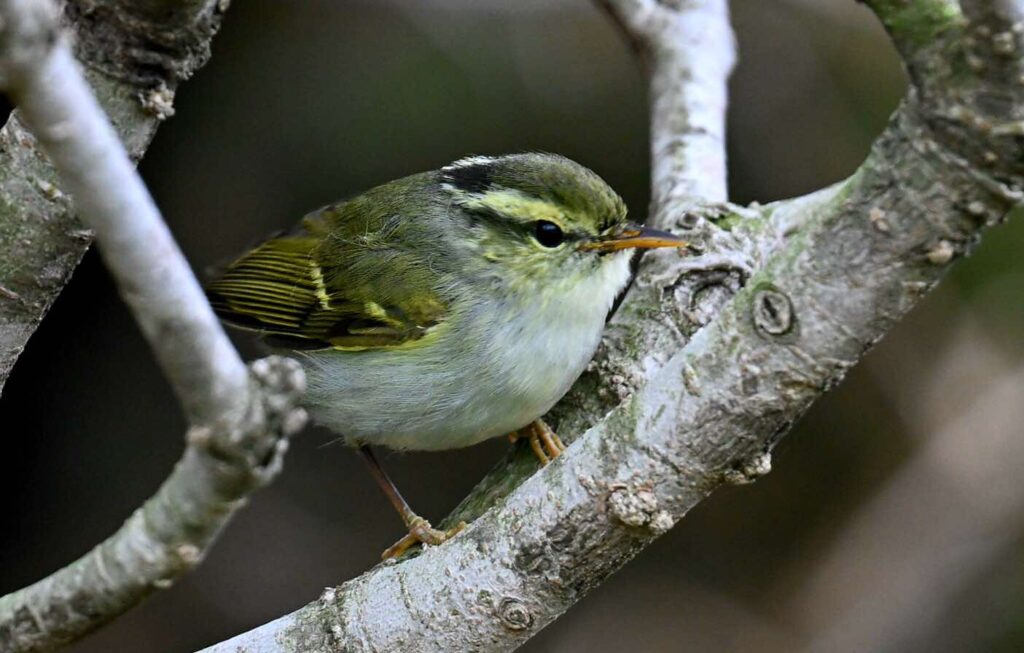
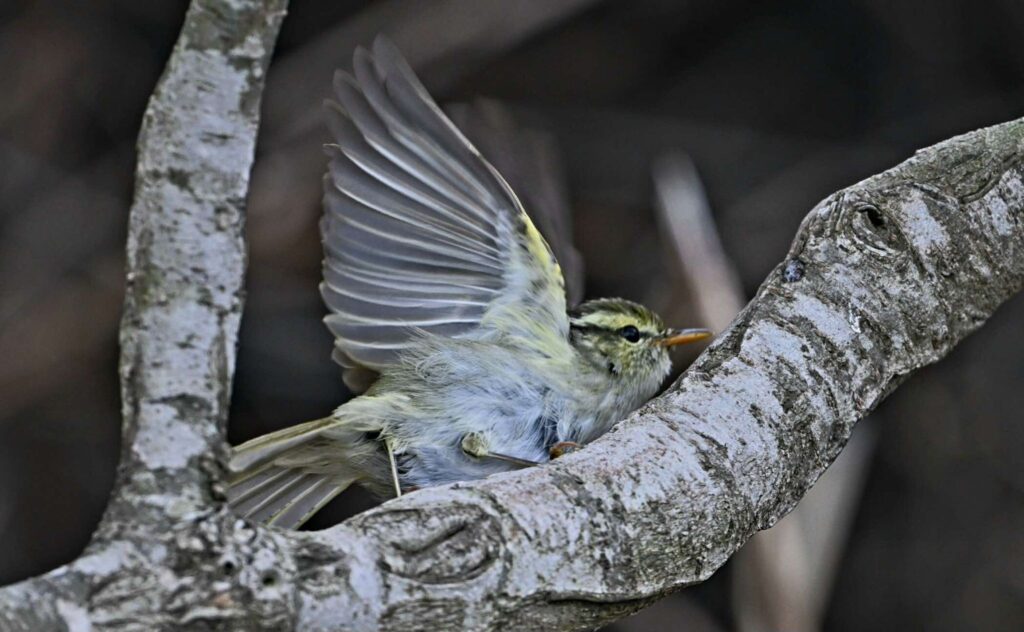
(1) A leaf warbler photographed on Mara Do, Jeju, April 4th was initially listed on eBird as a Claudia’s / Hartert’s by Dr Kim Sung-Hyun (https://ebird.org/checklist/S167191532). Following some expert review inside of Korea, this individual was then listed in a longer report as Claudia’s. ID as Claudia’s was primarily based, it appears, on a comparison of images with Blyth’s and on field-guide images and texts (e.g., Birds of Taiwan). This warbler was part of an exceptional arrival which also included two Sulphur-breasted Warbler P. ricketti (only 2-3 previous national records) and a Ferruginous Flycatcher (scarcely annual nationally) along with small numbers of e.g., Yellow-browed Warblers P. inornatus and a Pallas’s Leaf Warbler P. proregulus. This arrival followed very stormy conditions over southern China, which included multiple tornadoes.
(2) Thanks to the kind sharing of information and images by the finders, it has been possible for me to review seven images of this bird: four contained in entry 433 of this longer report, and three (Figures 1, 11 and 12) kindly shared separately by Mr Kang Heeman. The report states that no vocalisations were recorded. The bird moved through low bushes, as well hanging upside down like a Eurasian Nuthatch. This latter foraging behaviour is apparently shown by both Hartert’s and Claudia’s and much less so by Blyth’s (if ever: Round et al. 2023). As Blyth’s can effectively be ruled out on behaviour and range, all images show a bird which is clearly either Claudia’s or Hartert’s. Based on a combination of features, all other species can be safely excluded.
(3) On first seeing an image of the Marado leaf warbler (shared through Instagram), my persistent impression was that this bird looked brighter and not quite as heavy-billed as Claudia’s. Could this therefore be Korea’s first Hartert’s? Review of the four images in the longer report and the three images shared separately by Mr Kang Heeman suggest that structural, plumage and bare part features, combined with the date, indeed seem to fit Hartert’s at least as well as or quite possibly even better than Claudia’s – though in consideration of the importance of this record and the difficulty of ID, clearly more expert input is required to determine whether or not a confident ID to taxon can be made.
(4) The report text states that the bird looked intermediate between a Yellow-browed P. inornatus and an Arctic Warbler P. borealis in structure. To me, the neck looks rather short in the images, giving the bird a fairly neckless look, and making the bird appear quite small. My impression of Claudia’s is more like Eastern Crowned P. coronatus, with a more elongated shape than shown in many images of Hartert’s (especially when foraging).
(5) The report images, while perhaps a little overexposed (at least in reproduction in the report) suggest that the Jeju bird was largely olive-green or moss-green above, with paler, off-white underparts. Figures 1, 11 and 12 instead suggest an obviously bright-looking bird, with green upperparts. The supercilium and median crown stripe are highly contrasting. The forehead is greenish-grey, and the remainder of the median crown stripe is grey-green or perhaps grey admixed with green-yellow tones for most of its length, flaring slightly and becoming paler on the nape. The crown sides are greenish with a hint of yellow to above the eye and greener slightly behind (as shown in many images of Hartert’s and in rather few images of Claudia’s); and very dark only at the base of the nape. There is a very narrow, contrasting black or dark edge to the supercilium, with the supercilium looking quite Pallas’s Leaf Warbler like, in being golden yellow on the supra-lorals and above the eye (similar to many Hartert’s but fewer Claudia’s in online images), and yellowish (or rich cream) to the rear. There is a dark line on the lores, which peters out toward the bill base (a feature perhaps shown more often by Hartert’s). The eye-stripe is broader behind the eye, but most of the ear coverts are open-looking and streaked with yellow, again apparently a pattern shown by more Hartert’s than Claudia’s in online images. The underparts are whiteish, with some faint yellow streaking, including on the throat, with a stronger yellow wash on the axillaries and underwing coverts (Fig. 12). The mantle and back are green or moss-green (lacking the obviously colder greyer shawl shown by many Claudia’s, at least in one image, though looking greyer on the neck side in two of the images, as might be expected in Claudia’s and suggested in only a few images of Hartert’s). The mantle is more or less concolorous with the upperwing coverts (unlike many Claudia’s in spring). The remiges of the closed wing show a very bright, contrastingly green-gold blaze (perhaps typical of Hartert’s, perhaps stronger than expected in Claudia’s), as do the upperside of some of the rectrices. The bird shows two yellow-washed wing-bars (not white or whiteish as shown by some Claudia’s), fairly narrow on the median and broader on the greater coverts.
(6) The report images suggest that the lower mandible is bright orange (with no or only the faintest hint of a darker patch) and the culmen is darker. The legs are brownish or dark red-brown, with obviously yellower feet. Many images of Claudia’s suggest that the legs are often darker than this, perhaps especially in spring.
(7) The close-up image of the primaries appears to show similar spacing to online images of both Claudia’s and Hartert’s.
(8) Report images reveal that the upperside of the tail shows a narrow whiteish or grey-whiteish tip to the outermost pair, with this pale extending along the inner edge of the outermost feather, at least on the left side of the bird. The pale fringe that is visible appears to be rather less white and less extensive than might be expected in Claudia’s (based on my interpretation of two images in Alström 2012). The width of the pale at the tip of the outer pair of tail feathers therefore looks closer to that shown by Hartert’s in some online images (and in Alström 2012).
(9) The date of the record is substantially earlier than the three previous record(s) of Claudia’s / Hartert’s in Korea which were between April 14th and April 26th. Perhaps not enough is known yet about the migration phenology of these taxa and there are certainly too few records in Korea to use dates as more than weak support for any ID. However, the bird on Marado was found on the same date as two southern overshoot vagrant species (with their breeding distribution to the south or southwest of Korea) – and not with any vagrant species with an obviously more western or northwestern distribution It therefore seems likely that these three species were picked up by the same weather system more or less from the same region overnight on the 3rd, to be drifted out over the South China and Yellow Sea – with their first landfall Marado. Of potential interest in this regard, range maps in Birds of the World suggest substantial overlap in the eastern part of the range of fokiensis Hartert’s with Sulphur-breasted Warbler and Ferruginous Flycatcher and little overlap with Claudia’s, which has a generally more westerly distribution.
(10) By early August 2024, there were 675 eBird records for Claudia’s in the Beijing region. These records show a frequency of inclusion in checklists of 0.1% in the first quarter of April; rising to 1% in the third quarter; and to 3.3% in the fourth quarter of April (increasing to >7% in the first week of May). If there is no bias caused by differences in observer activity, this would suggest that the main arrival at a latitude similar to or to the north of Korea is late April. Further south, there are a total of 27 records of Claudia’s in the Shanghai region (if correctly identified), with the earliest in the first week of April, and the peak of records in the third quarter of April, again broadly matching the temporal pattern of records in Beijing (and of the three earlier records in Korea). In the case of Hartert’s, there are no records on eBird as far north as Shandong or Beijing and there are only five records in Shanghai (3 -4 in spring, with the “peak” in mid-April). However, there are 24 records further west in Anhui (at a more or less similar latitude to Jeju), with the first arrivals to forest breeding areas there as early as late March. It is therefore possible to conclude that based on present understanding, the date of the bird on Marado is a decent match for an overshooting Hartert’s; and a rather poor match for an overshooting Claudia’s.
In conclusion, in the absence of better information and without expert input from experienced observers, it seems unwise simply to rule out Hartert’s Leaf Warbler.
Listing all records of this species pair as Claudia’s might well discourage birders from fully documenting the next similar individual in Korea; and regionally might also result in some confusion over temporal patterns of occurrence of both taxa.
Instead, we have made the decision to seek the expert opinions of experienced observers. Can silent individuals of Claudia’s and Hartert’s be safely identified? How? Can “overlapping” vocalisations be used?

We especially welcome informed comments on the 2009 record and on the 2024 Marado record.
Thank you in advance for all and any comments that you might be able to provide!
Main sources of Information for this post include:
- Alström, P. 2012. Pdf on Identification of Phylloscopus & Seicercus warblers in China by Per Alström
- “Ayuwat Blog”. Post by Ayuwat Jearwattanakanok looking at identification of Blyth’s, White-tailed and Claudia’s leaf Warbler in Thailand
- del Hoyo, J., N. Collar, and D. A. Christie. 2020. Claudia’s Leaf Warbler (Phylloscopus claudiae), version 1.0. In Birds of the World (J. del Hoyo, A. Elliott, J. Sargatal, D. A. Christie, and E. de Juana, Editors). Cornell Lab of Ornithology, Ithaca, NY, USA. https://doi.org/10.2173/bow.clalew1.01
- Macaulay Library, dozens of images of both Hartert’s and Claudia’s Leaf Warblers in months March-May
- Round, P. D., Promnun, Pattarapon, Pierce, A. J., Sankamethawee, Wangworn, Allen, D. N., et al. 2023. Non-breeding season records of warblers in the Phylloscopus reguloides lineage from Thailand and Myanmar. Bulletin of the British Ornithologists’ Club, 143(2) : 265-272. Published By: British Ornithologists’ Club. URL: https://doi.org/10.25226/bboc.v143i2.2023.a11
Acknowledgements
Thanks to Kang Heeman for kindly sharing his images (and to Leslie Hurteau for contacting him on our behalf); to Dr Kim Sung-Hyun for sharing materials relevant to the identification; to Professor Phil Round for comments and a pdf of his 2023 paper; to Ayuwat Jearwattanakanok for kindly sharing his images and his thoughts on birds in Thailand; and to Nick Upton for comments relating to these species in China and Thailand.
